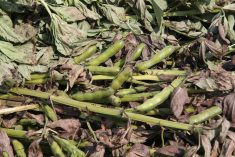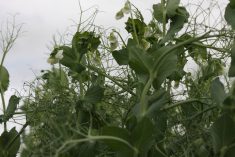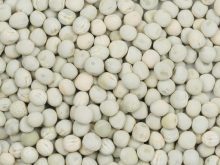Sluggish pulse sales to India have some analysts forecasting bourgeoning carryout while others believe there is no cause for alarm.
Bulk pea sales are 35 percent below last year’s pace, while bulk lentil shipments are 42 percent behind, according to Canadian Grain Commission statistics.
“We’ve been getting rather used to being very front-end loaded where there was a lot of pent-up demand and that is not the case this year,” said Marlene Boersch, managing partner with Mercantile Consulting Venture.
Sales are slow due to a myriad of issues in India and fierce competition from the Black Sea region.
India is coming off a year where it produced 23 million tonnes of pulses, 20 percent higher than the previous record. It also imported a staggering 6.6 million tonnes.

That has resulted in a stockpile of supplies, including government reserves of two million tonnes of pulses. The government has announced it will sell 700,000 tonnes of those reserves, reducing the need for further imports.
India also expects the second biggest kharif or summer pulse crop on record at 8.71 million tonnes and there is adequate soil moisture in many states for the rabi or winter crop that is about to be seeded.
The Hindu Business Line reports that the Indian government is contemplating putting an import duty on pulses, especially yellow peas, to help prop up domestic prices.
On top of all that, Canada is facing stiff competition from the Black Sea and Baltic Sea regions, which together are expected to harvest about four million tonnes of peas this year, matching the size of Canada’s crop.
Read Also

Critical growing season is ahead for soybeans
What the weather turns out to be in the United States is going to have a significant impact on Canadian producers’ prices
Those peas are being sold into India at up to $50 per tonne cheaper than Canadian peas.
It doesn’t help that Canadian exporters are facing new inspection fees amounting to about $15 per tonne when shipping pulses to India.
Add it all up and the early season outlook for exporting pulses to Canada’s top customer is rather grim.
“It’s going to be quiet for a while,” said Boersch. “Basically, we are kind of out of the market. We’re expecting we will be back in come the new year.”
The poor early season sales performance has some analysts forecasting bloated carryout. Larry Weber with Weber Commodities thinks there could be the highest lentil carryout since 2010 to 2012 when it was around 850,000 tonnes.
Greg Kostal with Kostal Ag Consulting believes lentil carryout could expand beyond last year’s 405,000 tonnes.
He said red lentil markets are “lethargic” and unlikely to improve any time soon as the market undergoes a correction after prices were too high for too long.
“This could take a while to turn the corner,” said Kostal.
It will take importers a long time to chew through global supplies that seem to be getting bigger. Pulse Australia’s latest crop estimate is for 540,000 tonnes of lentils, which is well above ABARES forecast of 419,000 tonnes.
However, Kostal is far more optimistic about the pea outlook due to strong demand and a 1.25 million tonne reduction in the North American crop.
“Peas have more support to them once (the former Soviet Union) hangs up the sold-out sign,” he said.
Boersch is not nearly as bearish about lentil demand as Weber and Kostal, forecasting 180,000 tonnes of carryout, which is less than half of what Agriculture Canada predicts.
Her pea carryout estimate is even lower at 150,000 tonnes, again well below Agriculture Canada’s 500,000 tonnes.
She expects pulse demand to pick up during the first three months of 2018. But she worries that farmers might be too eager to sell and that could drive down prices.
“Farmers have become used to being 60 percent sold when we get into the new year. This year they will be maybe 30 percent sold,” she said.
Growers need to realize that this year’s pea and lentil crops are much smaller than last year’s record crops.
She believes Canadian farmers harvested four million tonnes of peas, down from 4.8 million tonnes last year and 2.4 million tonnes of lentils, well below the 3.2 million tonnes harvested in 2016-17.
Boersch is especially bullish about pea demand despite the slow start in exports to India.
“We are looking at a much-reduced chickpea crop in Australia, that’s getting quite solidified and it makes peas more attractive, particularly at today’s prices,” she said.
Pulse Australia forecasts 1.18 million tonnes of chickpea production, down from 1.85 million tonnes last year.
“Once we have motored our way through some of the eastern European displacement there will be demand for Canadian peas,” said Boersch.

















